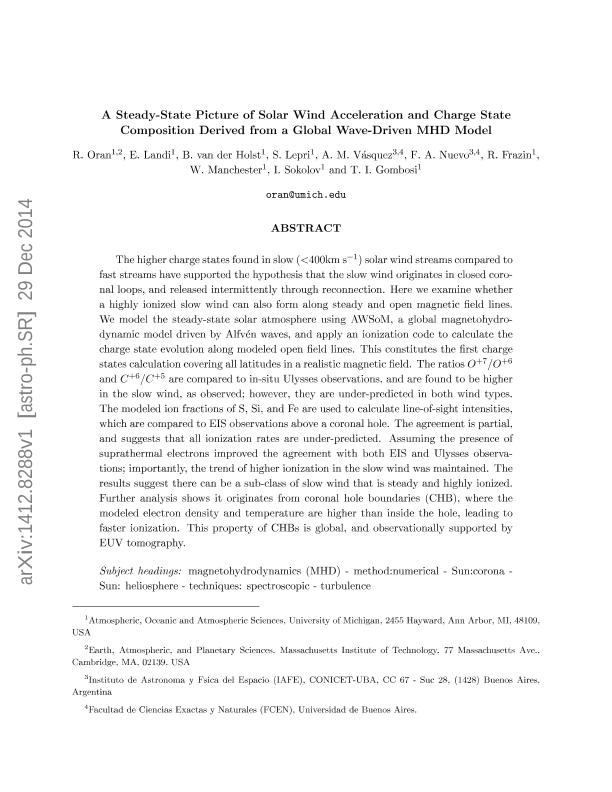Mostrar el registro sencillo del ítem
dc.contributor.author
Oran, R.
dc.contributor.author
Landi, E.
dc.contributor.author
Van Der Holst, B.
dc.contributor.author
Lepri, S. T.
dc.contributor.author
Vasquez, Alberto Marcos

dc.contributor.author
Nuevo, Federico Alberto

dc.contributor.author
Frazin, R.
dc.contributor.author
Manchester, W.
dc.contributor.author
Sokolov, I.
dc.contributor.author
Gombosi, T. I.
dc.date.available
2017-06-08T21:40:05Z
dc.date.issued
2015-06-10
dc.identifier.citation
Oran, R.; Landi, E.; Van Der Holst, B.; Lepri, S. T.; Vasquez, Alberto Marcos; et al.; A Steady-State Picture of Solar Wind Acceleration and Charge State Composition Derived from a Global Wave-Driven MHD Model; Iop Publishing; Astrophysical Journal; 806; 1; 10-6-2015; 1-25
dc.identifier.issn
0004-637X
dc.identifier.uri
http://hdl.handle.net/11336/17853
dc.description.abstract
The higher charge states found in slow (<400 km s−1) solar wind streams compared to fast streams have supported the hypothesis that the slow wind originates in closed coronal loops, and released intermittently through reconnection. Here we examine whether a highly ionized slow wind can also form along steady and open magnetic field lines. We model the steady-state solar atmosphere using AWSoM, a global magnetohydrodynamic model driven by Alfv{´e}n waves, and apply an ionization code to calculate the charge state evolution along modeled open field lines. This constitutes the first charge states calculation covering all latitudes in a realistic magnetic field. The ratios $O^{+7}/O^{+6}$ and $C^{+6}/C^{+5}$ are compared to in-situ Ulysses observations, and are found to be higher in the slow wind, as observed; however, they are under-predicted in both wind types. The modeled ion fractions of S, Si, and Fe are used to calculate line-of-sight intensities, which are compared to EIS observations above a coronal hole. The agreement is partial, and suggests that all ionization rates are under-predicted. Assuming the presence of suprathermal electrons improved the agreement with both EIS and Ulysses observations; importantly, the trend of higher ionization in the slow wind was maintained. The results suggest there can be a sub-class of slow wind that is steady and highly ionized. Further analysis shows it originates from coronal hole boundaries (CHB), where the modeled electron density and temperature are higher than inside the hole, leading to faster ionization. This property of CHBs is global, and observationally supported by EUV tomography.
dc.format
application/pdf
dc.language.iso
eng
dc.publisher
Iop Publishing

dc.rights
info:eu-repo/semantics/openAccess
dc.rights.uri
https://creativecommons.org/licenses/by-nc-sa/2.5/ar/
dc.subject
Sun: Heliosphere
dc.subject
Techniques: Spectroscopic
dc.subject
Turbulence
dc.subject.classification
Astronomía

dc.subject.classification
Ciencias Físicas

dc.subject.classification
CIENCIAS NATURALES Y EXACTAS

dc.title
A Steady-State Picture of Solar Wind Acceleration and Charge State Composition Derived from a Global Wave-Driven MHD Model
dc.type
info:eu-repo/semantics/article
dc.type
info:ar-repo/semantics/artículo
dc.type
info:eu-repo/semantics/publishedVersion
dc.date.updated
2017-06-06T14:48:40Z
dc.journal.volume
806
dc.journal.number
1
dc.journal.pagination
1-25
dc.journal.pais
Reino Unido

dc.journal.ciudad
Londres
dc.description.fil
Fil: Oran, R.. University Of Michigan; Estados Unidos
dc.description.fil
Fil: Landi, E.. University Of Michigan; Estados Unidos
dc.description.fil
Fil: Van Der Holst, B.. University Of Michigan; Estados Unidos
dc.description.fil
Fil: Lepri, S. T.. University Of Michigan; Estados Unidos
dc.description.fil
Fil: Vasquez, Alberto Marcos. Consejo Nacional de Investigaciónes Científicas y Técnicas. Oficina de Coordinación Administrativa Ciudad Universitaria. Instituto de Astronomía y Física del Espacio. - Universidad de Buenos Aires. Facultad de Ciencias Exactas y Naturales. Instituto de Astronomía y Física del Espacio; Argentina
dc.description.fil
Fil: Nuevo, Federico Alberto. Consejo Nacional de Investigaciónes Científicas y Técnicas. Oficina de Coordinación Administrativa Ciudad Universitaria. Instituto de Astronomía y Física del Espacio. - Universidad de Buenos Aires. Facultad de Ciencias Exactas y Naturales. Instituto de Astronomía y Física del Espacio; Argentina
dc.description.fil
Fil: Frazin, R.. University Of Michigan; Estados Unidos
dc.description.fil
Fil: Manchester, W.. University Of Michigan; Estados Unidos
dc.description.fil
Fil: Sokolov, I.. University Of Michigan; Estados Unidos
dc.description.fil
Fil: Gombosi, T. I.. University Of Michigan; Estados Unidos
dc.journal.title
Astrophysical Journal

dc.relation.alternativeid
info:eu-repo/semantics/altIdentifier/url/http://arxiv.org/abs/1412.8288v1
dc.relation.alternativeid
info:eu-repo/semantics/altIdentifier/doi/http://dx.doi.org/10.1088/0004-637X/806/1/55
dc.relation.alternativeid
info:eu-repo/semantics/altIdentifier/url/http://iopscience.iop.org/article/10.1088/0004-637X/806/1/55/meta
Archivos asociados
